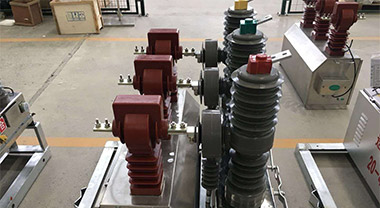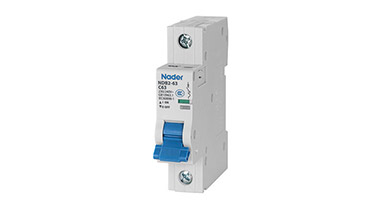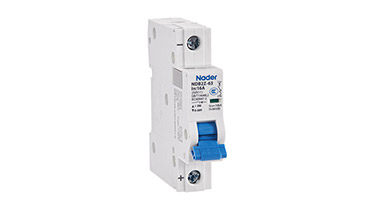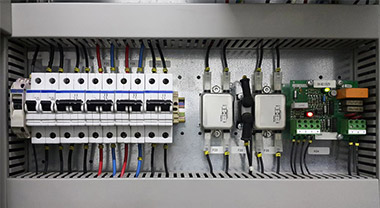What are the performance parameters of high voltage circuit breakers?
The high-voltage circuit breaker (or high-voltage switch) can not only cut off or close the no-load current and load current in the high-voltage circuit, but also cut off the overload current and short-circuit current through the function of the relay protection device when the system fails. The perfect arc extinguishing structure and sufficient current interruption capacity can be divided into: oil circuit breaker (more oil circuit breaker, less oil circuit breaker), sulfur hexafluoride circuit breaker (SF6 circuit breaker), vacuum circuit breaker, etc.
Rated voltage (nominal voltage): It is a parameter that characterizes the insulation strength of the circuit breaker, and it is the standard voltage for the long-term operation of the circuit breaker. In order to meet the requirements of the power system, the circuit breaker also specifies the highest operating voltage corresponding to the rated voltage of each level. For all levels of 3-220KV, the maximum working voltage is about 15% higher than the rated voltage; for 330KV and above, the maximum working voltage is about 10% higher than the rated voltage. The circuit breaker should be able to work reliably for a long time under the highest working voltage.
Rated current: It is a parameter that characterizes the ability of the circuit breaker to pass long-term current, that is, the maximum current that the circuit breaker allows to pass continuously for a long time.
Rated breaking current: It is a parameter that characterizes the breaking capacity of a circuit breaker. Under the rated voltage, the maximum current that the circuit breaker can guarantee reliable breaking is called the rated breaking current, and its unit is expressed in kiloamperes of the effective value of the periodic component of the short-circuit current at the moment of contact separation of the circuit breaker. When the circuit breaker works in a power grid that is lower than its rated voltage, its breaking current can increase. However, limited by the mechanical strength of the arc extinguishing chamber, the breaking current has a maximum value, which is called the limit breaking current.
Dynamic stability current: It is a parameter that characterizes the short-term current capacity of the circuit breaker and reflects the ability of the circuit breaker to withstand the electrodynamic effects of the short-circuit current. The maximum peak value of the current that the circuit breaker is allowed to pass in the closing state or at the moment of closing is called the electric stable current, also called the limit passing current. When the circuit breaker passes dynamic and stable current, it cannot be damaged by electromotive force.
Closing current: It is a parameter that characterizes the closing current capability of the circuit breaker. Because when the circuit breaker is switched on, there may be a short-circuit fault in the circuit, and the circuit breaker will close with a large short-circuit current. In this way, on the one hand, the electromotive force of the short-circuit current weakens the operating force of closing, and on the other hand, the arc is generated due to the breakdown of the contacts before they are in contact, which may cause the contacts to weld and cause damage to the circuit breaker. The maximum peak current that the circuit breaker can reliably close is called the rated closing current. The rated closing current and dynamic stability current are equal in value, and both are equal to 2.55 times the rated breaking current.
Thermally stable current and duration of thermally stable current: The stable current is also a parameter that characterizes the short-term current capacity of the circuit breaker, but it reflects the ability of the circuit breaker to withstand the thermal effect of the short-circuit current. Thermally stable current refers to the effective value of the maximum periodic component of the allowable current through the circuit breaker in the closed state for a certain duration. At this time, the circuit breaker should not be damaged due to short-term heating. The national standard stipulates that the rated thermal stability current of the circuit breaker is equal to the rated breaking current. The duration of the rated thermal stability current is 2S, when it needs to be greater than 2S, 4S is recommended.
Closing time and opening time: This is a parameter that characterizes the operating performance of the circuit breaker. Different types of circuit breakers have different opening and closing times, but they all require rapid action. The closing time refers to the time from the closing coil of the operating mechanism of the circuit breaker to the contact of the main contact. The opening time of the circuit breaker includes two parts: the inherent opening time and the arc extinguishing time. The inherent opening time refers to the period from when the opening coil of the operating mechanism is turned on to when the contacts are separated. The arc extinguishing time refers to the period from the separation of the contacts to the extinguishment of the arc of each phase. Therefore, the opening time is also called full opening time.
Operating cycle: This is also an indicator of the operating performance of the circuit breaker. Most of the short-circuit faults of overhead lines are temporary, and the fault disappears quickly after the short-circuit current is cut off. Therefore, in order to improve the reliability of power supply and the stability of system operation, the circuit breaker should be able to withstand one or more times of closing, breaking, or breaking immediately after closing. This type of operation of multiple opening and closing at a certain time interval is called an operating cycle.




